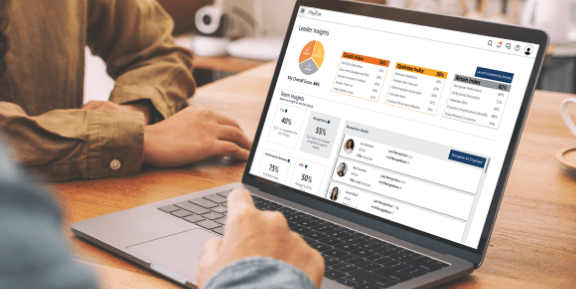To manage workforce data, more and more companies are relying on software solutions. In fact, Fortune Business Insights reports the global HR technology market size is projected to grow from $40.45 billion in 2024 to $81.84 billion by 2032, showing a compound annual growth rate (CAGR) of 9.2%.
A common solution for people data management is a human resources information system (HRIS). Read on for the definition of HRIS, HRIS benefits, HRIS components, and more.
What is an HRIS?
An HRIS is a software solution used by HR departments to store and manage employee information. It serves as a centralized digital platform that consolidates all workforce data into a single, secure database.
HRIS vs HRMS vs HCM
An HRIS is often confused with two other types of HR software: a human resources management system (HRMS) and a human capital management (HCM) system. Though some use the terms interchangeably, there are slight differences.
An HRIS is basically a central place to keep track of employee information. HRMS steps things up, not just storing data but also handling essential HR tasks—think payroll, benefits, and more. HCM pulls it all together and goes beyond, adding tools for things like workforce planning, talent management, and succession planning.hcm
What Does an HRIS Do?
The functions of an HRIS can be split into two categories:
1. Organizational Consistency
An HRIS creates enterprise-wide standardization by automating essential data collection workflows, eliminating the need for HR teams to manually track and request information. For example, the system streamlines onboarding by automatically collecting new hire paperwork, scheduling required training sessions, and ensuring all compliance documentation is completed before an employee’s start date.
This centralized, scalable approach to data consistency becomes even more important in today’s work environment, particularly as hybrid work models continue to dominate the corporate landscape across organizations nationwide.
2. Data Insights
Beyond simply storing employee information, an HRIS transforms raw data into actionable insights for HR professionals. The system enables comprehensive career path tracking and planning, including monitoring growth trajectories and promotion readiness. Through this strategic approach, organizations can quickly identify areas requiring attention and proactively chart and manage employee development opportunities.
This data-driven foundation allows HR teams to move from reactive administrative tasks to proactive talent management and strategic workforce planning.
Functions of HRIS Software

The functions HRIS software and HRMS often include are:
Recruiting and Applicant Tracking
HR software solutions often include tools to manage the entire recruiting process — from posting jobs to tracking candidates through each stage of the hiring funnel. They can automate resume screening, support collaboration between hiring managers, and store candidate data for future roles, making it easier to build a strong talent pipeline.
Onboarding
The onboarding module within an HRIS transforms new hire integration from a paperwork nightmare into a structured, efficient process by automating document collection. New employees can complete tax forms, review company policies, and set up direct deposit before their first day, ensuring a smooth transition into the organization.
Payroll
Payroll functionality automates the calculation of employee wages, tax withholdings, and deductions. It ensures timely and accurate payments through direct deposit or printed checks and simplifies year-end reporting by generating forms like W-2s and 1099s. This reduces errors and saves time compared to manual payroll processing.
Time and Attendance
Time and attendance tracking allows businesses to monitor employee hours worked, manage time-off requests, and calculate overtime. This data integrates with payroll to ensure employees are paid correctly and in compliance with labor laws regarding breaks, holidays, and leave policies.
Scheduling
Advanced scheduling tools help managers create optimal work schedules based on employee availability, skill sets, and business demands. An HR system with scheduling functionality can automatically generate schedules, handle shift swaps, manage time-off requests, and send notifications to affected employees. This functionality is particularly valuable for organizations with complex scheduling needs or shift-based operations.
Benefits Administration
HRIS platforms simplify benefits administration by providing employees with self-service enrollment portals, automated eligibility tracking, and real-time benefits information access. The software manages health insurance selections, retirement plan contributions, flexible spending accounts, and other benefit programs, while ensuring compliance with regulatory requirements and streamlining annual open enrollment periods.
Compliance
Many HR systems include built-in compliance features to help organizations maintain adherence to employment laws, safety regulations, and industry standards. The software generates required reports, tracks certification expirations, maintains audit trails, and provides automated reminders for compliance deadlines. This functionality reduces legal risk and ensures organizations stay current with evolving regulatory requirements.
Reporting
Comprehensive reporting capabilities transform raw HR data into actionable business insights. HRIS platforms generate standard reports on headcount, turnover, compensation, and performance metrics, offering customizable dashboards for strategic analysis. Advanced analytics help identify trends, predict workforce needs, and support data-driven decision making across the organization.
How Does an HRIS Software Work?

An HRIS operates as a centralized digital hub that collects, stores, and manages employee data through automated workflows and user-friendly interfaces. The system gathers information from multiple sources including employee self-service portals, manager inputs, time clocks, and integrated third-party applications like payroll providers and benefits administrators. This data flows into a secure, centralized database that serves as the single source of truth for all employee information across the organization.
The platform delivers functionality through role-based access controls, providing customized interfaces for employees, managers, and HR professionals. Employees can update personal information and submit requests through self-service portals, while managers access team-specific tools for approvals and scheduling. Meanwhile, HR teams work with comprehensive administrative dashboards that enable full system management, reporting, and configuration.
Benefits of HRIS Software
Key benefits of HRIS software include the following:
Centralized Employee Data
HRIS software provides a single source of truth for employee information, including personal details, job history, compensation, and performance records. This centralization eliminates the need for multiple spreadsheets or disconnected systems, making it easier to access accurate, up-to-date data across departments.
Improved Accuracy
Manual data entry is prone to errors that can lead to payroll mistakes or compliance issues. HRIS software reduces the risk of human error by automating calculations and syncing information across functions like payroll, benefits, and timekeeping.
Better Compliance
Many HRIS platforms offer built-in tools and reminders to help businesses comply with labor laws, tax requirements, and industry regulations. Features like audit trails, secure document storage, and policy tracking simplify recordkeeping and reduce the risk of non-compliance penalties.
Enhanced Reporting and Analytics
HRIS platforms provide real-time access to workforce metrics, from turnover rates to payroll costs. These reporting tools allow HR teams and executives to make informed decisions based on trends, forecasts, and benchmarks.
Employee Self-Service
Self-service portals empower employees to view pay stubs, request time off, update personal information, and enroll in benefits — all without going through HR. This reduces administrative burden, in addition to improving employee satisfaction and transparency.
Scalable for Growth
As companies grow, so do their HR needs. An HRIS is designed to scale with the business, offering additional features or integrations as needed. This makes them a long-term solution that can support evolving workforce demands.
Cost Savings
While HRIS software requires an upfront investment, it often leads to cost savings over time by reducing manual processes, minimizing errors, and improving operational efficiency. Many companies also save on legal and compliance-related costs through better recordkeeping and automation.
How to Choose HRIS Software
Selecting the right HRIS depends on your business size, needs, and growth plans. Key considerations to guide your decision include:
Functionality
Start by evaluating what your organization needs most, whether it’s payroll automation, benefits administration, time tracking, or recruitment support. Make a list of must-have features and prioritize systems that directly address those requirements.
Scalability
Choose an HRIS that can grow with your business. A scalable system allows you to add features, support more users, or integrate with other platforms as your workforce expands and your HR complexity increases.
Ease of Use
A user-friendly interface makes a big difference when it comes to successful adoption. Intuitive dashboards, mobile access, and clear navigation empowers HR staff and employees to use the system with minimal training.
Integration Capabilities
Ensure the HRIS integrates smoothly with your existing tools, such as payroll, accounting, or timekeeping software. This reduces duplicate data entry and helps maintain consistent, accurate records.
Costs and ROI
Understand both upfront and ongoing costs, including implementation, subscription fees, and support. Balance pricing against time saved, error reduction, and compliance improvements to assess long-term value.
How to Implement a New HRIS
Follow these steps for successful implementation:
- 1. Form an implementation team that includes representatives from HR, IT, payroll, and other relevant departments to oversee the rollout.
- 2. Set clear objectives for what the HRIS should achieve, and establish a realistic launch schedule.
- 3. Review, update, and organize employee records before migrating them to the new system.
- 4. Configure the HRIS based on your organization’s structure, policies, and workflows.
- 5.Provide training for HR staff, managers, and employees to ensure everyone understands how to use the new platform.
- 6. Run a pilot phase to check for errors, gather feedback, and make any necessary adjustments.
- 7.After launch, continue monitoring performance and user adoption to refine the system based on feedback.
Should I Get an HRIS for My Business?
The decision to implement an HRIS depends on your organization’s size, complexity, and growth trajectory, but most businesses with 50 or more employees will find significant value in these systems. If your HR team currently spends substantial time on manual data entry, struggles with compliance reporting, or lacks visibility into workforce analytics, an HRIS can deliver immediate operational improvements and cost savings.
Importance of Human Resource Information Systems
An HRIS acts as the backbone of HR operations by storing employee data, automating administrative tasks, and ensuring consistent and compliant processes. The value of an HRIS goes beyond efficiency though. It also supports strategic decision-making by offering real-time data and reporting tools.
With a reliable HRIS, organizations can improve accuracy, enhance the employee experience, and stay agile in a changing business landscape. Ultimately, it’s a foundational tool for building a well-organized, scalable, and future-ready HR function.
Human Resources Information System (HRIS) FAQ
Still have questions about an HRIS? Read on.
How Does an HRIS Work?
An HRIS works by centralizing employee data in a secure database and automating HR workflows through role-based user interfaces. The system collects information from employees, managers, and integrated applications, then processes this data through automated rules and approval workflows to handle tasks like payroll, benefits administration, and compliance reporting.
Who Uses an HRIS?
HR teams, managers, payroll staff, and employees all use an HRIS to manage HR processes, access data, and complete HR-related tasks.
Who Benefits from an HRIS?
All organizational stakeholders benefit from an HRIS. HR teams gain efficiency and strategic capabilities. Employees enjoy self-service convenience and faster processing. Managers receive better visibility into team data. Executives get data-driven insights for strategic decision-making.
What Problems Does an HRIS Solve?
An HRIS reduces manual paperwork, eliminates data errors, streamlines compliance, improves reporting, and simplifies employee management.
How Does an HRIS Help HR Leaders?
An HRIS helps HR leaders by automating routine tasks, providing workforce analytics for strategic planning, ensuring compliance with employment laws, reducing administrative costs, improving data accuracy, and enabling them to focus on talent management and organizational development rather than paperwork.
How Does an HRIS Help Employees?
HRIS software helps employees by providing 24/7 access to personal information, enabling self-service updates and requests, offering transparent benefits enrollment, providing easy access to pay stubs and tax documents, and streamlining processes like time-off requests and performance reviews.
Does an HRIS Include Payroll?
Many HRIS platforms include integrated payroll functionality or seamlessly connect with payroll providers. However, some basic HRIS systems focus primarily on employee data management and require separate payroll solutions, depending on the specific platform and package selected.
Is Paycor an HRIS?
Paycor offers all the features of an HRIS and more. We consider ourselves human capital management software.
How Paycor Helps
Paycor provides a fully featured HRIS, in addition to offering features for a variety of HR and human capital needs, including:
- Applicant Tracking System
- Onboarding
- Time and Attendance
- Analytics
- Payroll
- Benefits Administration
- Talent Development
Ultimately, Paycor’s intelligent HCM software helps HR leaders save time, save money, and stay compliant.
Enhance Business Operations with Paycor Payroll and HRIS Software
Ready to get out of the weeds with a unified HR platform that serves as a single source of truth for employee data? Learn why 50,000+ customers trust Paycor with their workforce management needs. Take a guided product tour.









